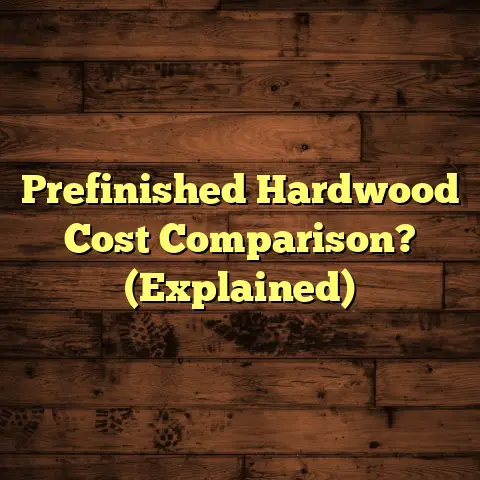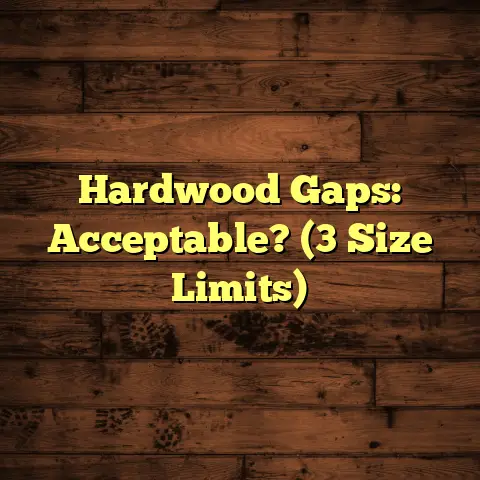Can Vinyl Floor Planks Be Used On Walls? (Explained)
Isn’t it ironic how we often think of floors as the foundation of a room, yet some of the most interesting design choices can happen on the walls?
This paradox has intrigued me throughout my years as a flooring contractor.
While I’ve dedicated countless hours to perfecting floor installations, I’ve also found myself exploring the creative possibilities of using flooring materials in unconventional ways.
One question that frequently arises among clients and fellow contractors is, “Can vinyl floor planks be used on walls?”
Let me share my thoughts and experiences on this topic, as well as some practical tips that might help you in your own projects.
The Versatility of Vinyl Floor Planks
Vinyl floor planks have gained immense popularity over the years due to their durability, ease of installation, and wide range of styles.
When I first started working with vinyl, I was surprised by how versatile it could be.
Not only did it serve as an excellent flooring option, but I began to see its potential for wall applications.
My First Experience with Vinyl on Walls
My first project that involved using vinyl planks on walls was in a cozy cafe in my neighborhood.
The owner wanted to create an inviting atmosphere with a rustic touch.
After discussing various options, we decided to use wood-look vinyl planks vertically on one feature wall.
The installation process was straightforward.
We used a strong adhesive designed for both flooring and wall applications, allowing us to achieve a seamless look.
The result was stunning!
The texture and color of the vinyl planks brought warmth to the space, and the owner received numerous compliments from customers.
Design Considerations
When considering using vinyl planks on walls, there are a few design elements to keep in mind:
- Style: Choose planks that complement the overall design of the room.
For example, if you’re going for a modern look, opt for sleek, monochromatic colors. - Height: Decide how high you want the planks to go.
In my cafe project, we went about two-thirds up the wall, which created a balanced look without overwhelming the space. - Layout: Consider whether you want a straight lay or a more dynamic pattern.
A staggered pattern can add visual interest but may require more planning during installation.
Installation Tips
If you decide to take the plunge and install vinyl planks on your walls, here are some tips from my experience:
- Surface Preparation: Ensure the wall surface is clean, dry, and smooth.
Any imperfections can affect the adhesive bond. - Use the Right Adhesive: Not all adhesives are suitable for both flooring and walls.
Make sure to choose one specifically designed for wall applications. - Cutting Planks: Use a utility knife for clean cuts.
Measure twice before cutting to avoid wasting material. - Starting Point: Begin at the center of your wall and work your way outwards.
This helps create a balanced appearance. - Alignment: Use a level to ensure your planks are straight.
There’s nothing worse than finishing up only to realize your lines are off!
Addressing Challenges
While my experience with vinyl planks on walls has been largely positive, I encountered challenges along the way.
One notable issue was dealing with temperature fluctuations in certain spaces.
In a commercial setting, varying temperatures can cause vinyl to expand or contract, affecting its adhesion on walls.
To combat this, I always advise clients to keep their spaces climate-controlled during and after installation.
Additionally, using a higher-quality adhesive can help prevent issues down the line.
Cost Estimation with FloorTally
As I mentioned earlier, accurate cost estimation is crucial in any flooring project, including when installing vinyl on walls.
I rely heavily on FloorTally for this purpose.
It pulls local material and labor rates directly from my area, allowing me to provide clients with realistic budgets right from the start.
For instance, in that cafe project, I used FloorTally to calculate both the material costs for the vinyl planks and the labor involved in installation.
The estimates helped me present a transparent budget that included everything—from adhesive to potential waste factors—so the cafe owner knew exactly what to expect financially.
Maintenance Considerations
Once you’ve installed vinyl planks on your walls, it’s essential to think about maintenance:
- Cleaning: Use a damp cloth or mild detergent to wipe down surfaces.
Avoid harsh chemicals that could damage the finish. - Repairs: If a plank gets damaged, replacing it is generally straightforward.
Just carefully remove the affected plank and replace it with a new one using the same adhesive.
Comparing Vinyl Planks with Other Wall Options
While vinyl planks offer unique advantages, it’s worth considering how they stack up against other wall options:
- Wood Paneling: Traditional wood offers unmatched aesthetic appeal but requires more maintenance and can be susceptible to warping.
- Paint: A cost-effective choice but lacks texture and depth compared to vinyl.
- Tile: Durable and water-resistant but often requires complex installation techniques.
In my experience, vinyl planks provide a great middle ground: they’re stylish, easy to install, and low-maintenance.
Innovative Uses for Vinyl Planks on Walls
Beyond simple applications in cafes or homes, there are various innovative ways to utilize vinyl planks on walls that I’ve seen or implemented over the years.
Accent Walls
Creating an accent wall is one of the simplest and most effective ways to bring vinyl into wall design.
In one residential project, I used vibrant colored vinyl planks in a child’s playroom.
The bright colors not only made the room feel fun but were also easy to clean when crayons ended up where they shouldn’t have!
Full-Wall Installations
In larger spaces like commercial offices or trendy restaurants, full-wall installations can lead to dramatic results.
One memorable project involved installing large-format wood-look vinyl planks across an entire wall in a restaurant’s waiting area.
The effect was stunning and helped create an inviting atmosphere for diners.
Creative Patterns
I’ve also experimented with creating geometric patterns using different colored or textured vinyl planks.
This approach worked particularly well in a trendy boutique where we mixed matte black and glossy white planks to create a striking visual impact.
Practical Applications in Different Spaces
Vinyl planks aren’t just versatile; they also serve practical purposes across various environments.
High-Moisture Areas
One of my favorite aspects of vinyl is its durability in high-moisture areas like bathrooms or kitchens.
For instance, I once worked on a spa renovation where we installed waterproof vinyl planks on both floors and walls.
The result was not only aesthetically pleasing but also functional; it stood up beautifully against humidity without warping or peeling.
Sound Absorption
In busy environments like gyms or music studios, sound absorption is key.
Using vinyl planks on walls can help dampen noise levels while adding an attractive finish.
During one gym project, we installed acoustic-grade vinyl panels that not only looked good but also minimized sound echoing throughout the space.
Kids’ Rooms
Kids can be tough on walls!
With their propensity for messy playtime activities, installing durable vinyl planks can be a game-changer in children’s rooms.
I recommend using colorful designs that appeal to kids while ensuring easy cleaning following any artistic endeavors.
Challenges Faced During Installation
While I’ve had many successes with vinyl plank installations on walls, there have also been challenges I’ve had to navigate.
Uneven Surfaces
One challenge I frequently encounter is dealing with uneven wall surfaces.
In older homes or commercial buildings, walls may not be perfectly straight or smooth.
To tackle this issue, I often use drywall compound to fill in low spots before installation begins.
Adhesive Issues
Another common problem is adhesive failure due to improper application or unsuitable conditions (e.g., high humidity).
In one instance, I learned this lesson the hard way when some planks began to peel away from the wall shortly after installation in a humid environment.
Since then, I’ve made it a priority to educate clients about choosing appropriate adhesives based on their specific environments.
Sustainability Considerations
With growing concerns about sustainability in construction and design, it’s important to consider eco-friendly options when selecting materials.
Choosing Eco-Friendly Vinyl
Not all vinyl is created equal!
Some manufacturers produce eco-friendly options that use recycled materials or low-VOC adhesives.
When sourcing materials for projects, I always check for certifications like GreenGuard or FloorScore that indicate lower environmental impact.
Reusability of Vinyl Planks
One of the perks of using vinyl planks is their reusability.
If ever you decide to change up your decor, gently removing and repurposing these materials is often possible without significant waste—something I always appreciate as someone committed to minimizing environmental impact.
Tips for Choosing Vinyl Planks for Walls
Choosing the right vinyl plank for wall applications can feel daunting given the vast array of options available.
Here are a few tips I’ve gathered over my years of experience:
- Research Material Specifications: Look beyond aesthetics; research each plank’s durability ratings and suitability for wall use.
- Consider Thickness: Thicker planks may provide better insulation and sound absorption—ideal for noisy environments like restaurants or gyms.
- Match Your Environment: Think about how color and texture will interact with existing elements in your space—lighting plays an essential role!
- Think About Maintenance: Some finishes are easier to clean than others; choose wisely based on your anticipated use.
Vinyl Plank Trends
The world of interior design is always evolving!
Here are some current trends I’ve observed regarding vinyl planks used on walls:
Textured Finishes
Textured finishes are becoming increasingly popular as they add depth and dimension to spaces.
Brands have started offering more options like embossed wood grains or stone looks that create an authentic feel without compromising durability.
Bold Colors
Gone are the days when neutral tones dominated home design!
Bright colors are making their way onto walls through vinyl applications—perfect for those wanting an eye-catching statement piece.
Mixed Materials
It’s not uncommon now for designers to mix materials within a single space—think combining vinyl planks with metal accents or even glass features!
This eclectic approach creates unique environments that resonate well with modern aesthetics.
Final Thoughts
Using vinyl floor planks on walls opens up a world of design possibilities that many people overlook.
From my personal experiences—successes and challenges alike—it’s clear that with careful planning and execution, these versatile materials can transform any space.
So, what do you think?
Are you ready to explore adding some vinyl flair to your walls?
Whether it’s for a residential project or a commercial space like my cafe experience, there’s plenty of potential waiting to be tapped into.
Feel free to ask questions or share your own experiences with vinyl installations; I’m always here for a friendly chat about flooring!





